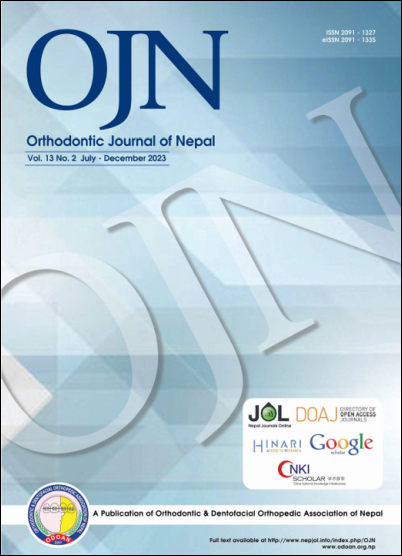The Prevalence of Alveolar Bone Dehiscence and Fenestration among untreated patients with different patterns of vertical growth using cone-beam computed tomography
DOI:
https://doi.org/10.3126/ojn.v13i2.52399Keywords:
Alveolar Bone Defect, Dehiscence, Fenestration, Vertical growth pattern, Cone-Beam Computed Tomography (CBCT)Abstract
Introduction: Alveolar bone dehiscence and fenestration are generally present within the area of the mal-position tooth which complicates the orthodontic treatment. With the advancement of radiology, Cone-beam computed tomography (CBCT) is preferred to identify alveolar bone dehiscence and fenestration among dental patients prior to orthodontic treatment.
Aims and objectives: The purpose of this study was to determine the prevalence of alveolar bone dehiscence and fenestration among patients having different patterns of vertical growth using CBCT.
Materials and Method: CBCT images of 141 patients ranging from 18 to 30 years old were used to measure alveolar bone dehiscence and fenestration. According to the vertical growth pattern of these patients, they were further divided into three groups: hyper-divergent group, normo-divergent group and hypo-divergent group. All the data were measured in Materialise Mimics 21.0 software and statistically analyzed.
Results: The alveolar bone dehiscence and fenestration were found in 48.3% and 14.91% respectively.
Pearson chisquare test showed statistically signifiant association between alveolar bone dehiscence and fenestration with the patient with different vertical growth patterns (p<0.001). Both dehiscence and fenestration were prevalent in hyperdivergent and normodivergent growth patterns compared to hypodivergent growth patterns. Dehiscence was more prevalent in maxillary fist premolar (9.58%) and mandibular central incisors (8.64%) while fenestration was more prevalent in maxillary canine (21.22%) and mandibular lateral incisors (16.47%).
Conclusion: Alveolar bone dehiscence and fenestration were prevalent among all three vertical growth patterns group. Among these three vertical growth pattern groups, hypo-divergent group had lesser incidence of alveolar bone dehiscence and fenestration owing to comparatively thick alveolar bone in this group.
Downloads
Downloads
Published
How to Cite
Issue
Section
License
Copyright (c) 2024 Orthodontic & Dentofacial Orthopedic Association of Nepal

This work is licensed under a Creative Commons Attribution 4.0 International License.
Copyright © held by Orthodontic & Dentofacial Orthopedic Association of Nepal
- Copyright on any research article is transferred in full to the Orthodontic & Dentofacial Orthopedic Association of Nepal upon publication in the journal. The copyright transfer includes the right to reproduce and distribute the article in any form of reproduction (printing, electronic media or any other form).
- Articles in the Orthodontic Journal of Nepal are Open Access articles published under the Creative Commons CC BY License (https://creativecommons.org/licenses/by/4.0/)
- This license permits use, distribution and reproduction in any medium, provided the original work is properly cited.




